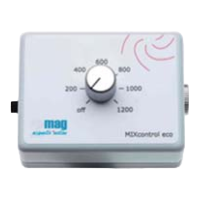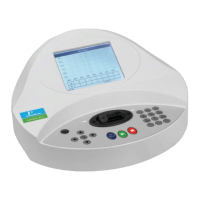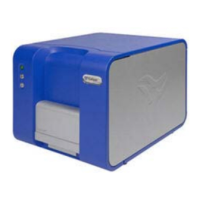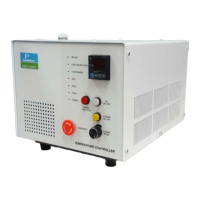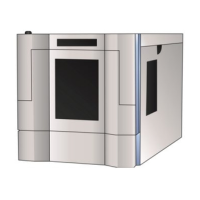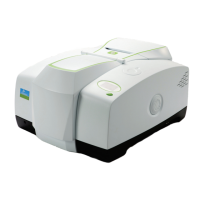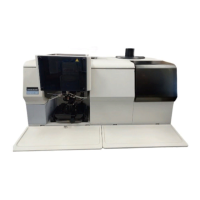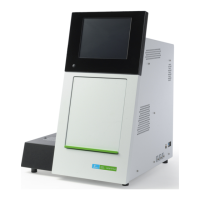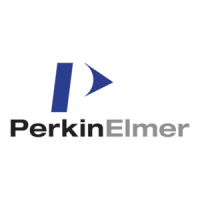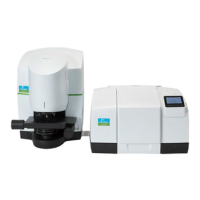Do you have a question about the PerkinElmer QuantaSmart 1694267 and is the answer not in the manual?
Covers essential safety precautions related to electrical connections and grounding.
Details the computer control system, ports, and network connectivity options for the instrument.
Defines preset energy regions for nuclides and explains how to define custom regions.
Specifies minimum acceptable counting efficiencies for Tritium and Carbon-14.
Defines the acceptable range for the Chi-Square test used in performance assessment.
Provides a table listing the physical dimensions of all TriCarb models.
Describes the photomultiplier tubes (PMTs) and their placement in the instrument.
Outlines recommended operating temperatures, humidity, and placement guidelines for the instrument.
Explains the operation, capacity, and movement of the optional automatic sample changer.
Details the voltage, amperage, and fuse requirements for the instrument and refrigeration unit.
Specifies the type and activity of external standards recommended for calibration.
Provides average background count rates for Tritium and Carbon-14 in Normal Count Mode.
Describes the plastic racks holding vials and their identification methods for positive sample identification.
Details the minimum lead shielding surrounding the detector assembly.
Specifies the required sizes for large vials, small vials, and 4ml vials, including cap diameter limits.
Outlines the initial steps for beginning a counting procedure with the QuantaSmart software.
Steps for Self-Normalization and Calibration, including for systems with/without BGO guard.
Outlines the sequence of actions required to define and initiate an assay.
Guides the user through setting a password to protect assay parameters from unauthorized editing.
Explains how to create, define, and associate a new assay with a protocol.
Describes linking defined assay parameters to a specific protocol flag for sample processing.
Details the process of loading samples, setting up cassettes, and initiating the counting procedure.
Explains how to remove an assay's association from a protocol flag.
Guides the user on how to modify the parameters of an existing assay definition.
Describes how to print the defined parameters of a selected assay.
Details linking quench sets from the library to specific sample nuclides for accurate DPM calculations.
Outlines the tasks required for creating and performing a Quench Standards Assay.
Explains how to set up and perform an Alpha Beta assay for simultaneous alpha/beta counting.
Guides on running standards to establish optimal pulse decay discriminator values for Alpha Beta assays.
Describes how to reanalyze previously collected data using different reduction conditions.
Explains how to use the nuclide decay calculator to determine current DPM activity.
Provides steps to adjust the system's date and time settings.
Explains how to connect the system to a network using an optional kit.
Covers Main Window, Output Window, SpectraView, Status Bar, Protocols Tree, and Replay Tree elements.
Details the Menus (File, Run, View, etc.), Libraries (Nuclide, Quench), and Tools menu options.
Explains Select Assay Type, Associate/Disassociate Assay, Data Paths, Reports, and Electronic Reports.
Covers Protocol Errors, Spectral Mapping, Spectrum Unfolding, IPA, Diagnostics, and Help functions.
Introduces CPM, DPM, FS DPM, Direct DPM, Alpha Beta, and SPC assays.
Details defining assays using parameters, count conditions, corrections, and reports.
Explains Quench Indicators, Background Subtract methods, and terminators.
Explains the purpose and structure of Nuclide, Quench, and Alpha Beta Libraries.
Details using Sample Nuclides Library, Quench Sets, Quench Standards, and Alpha Beta Libraries.
Describes the procedures for synchronizing PMTs and quantifying beta emissions.
Details IPA parameters, definition, charts, tables, and reports.
Step-by-step guides for Self-Normalization and Calibration (SNC) and IPA.
Covers Group Priostat and Sample Priostat modes for priority sample counting.
Details Decay, SPC Decay, Identify Nuclide, Optimize Regions, Reverse Region, Low Level Optimize, Previews.
Explains Replay feature, Quench Indicators, Background Subtraction, and Counting Modes (HS/LL/SLL).
Explains alpha/beta separation using PDA and optimizing pulse decay discriminator.
Covers inspection, cleaning, and backing up instrument data.
Addresses common issues like sample changer problems, display, printout, and protocol errors.
Guides on resolving IPA parameter errors and system-level issues.
Explains various system messages and warnings encountered during operation.
Explains Background Correction, Threshold, Chi-Square, DPM, Efficiency, and Figure of Merit calculations.
Details Half-life Correction, IPA Background, LCR, LUM, Radioactivity Units, and 2 Sigma %.
Covers Radionuclide Decay Calculator and % Reference calculation methods.
Discusses detectability limits, efficiency, background noise, and sensitivity enhancement.
Explains TR-LSC circuitry for background discrimination and pulse differentiation.
Details High/Low Level modes, setup, limitations, and operational considerations.
Explains alpha/beta separation using PDA and optimizing pulse decay discriminator.
Covers essential safety precautions related to electrical connections and grounding.
Details the computer control system, ports, and network connectivity options for the instrument.
Defines preset energy regions for nuclides and explains how to define custom regions.
Specifies minimum acceptable counting efficiencies for Tritium and Carbon-14.
Defines the acceptable range for the Chi-Square test used in performance assessment.
Provides a table listing the physical dimensions of all TriCarb models.
Describes the photomultiplier tubes (PMTs) and their placement in the instrument.
Outlines recommended operating temperatures, humidity, and placement guidelines for the instrument.
Explains the operation, capacity, and movement of the optional automatic sample changer.
Details the voltage, amperage, and fuse requirements for the instrument and refrigeration unit.
Specifies the type and activity of external standards recommended for calibration.
Provides average background count rates for Tritium and Carbon-14 in Normal Count Mode.
Describes the plastic racks holding vials and their identification methods for positive sample identification.
Details the minimum lead shielding surrounding the detector assembly.
Specifies the required sizes for large vials, small vials, and 4ml vials, including cap diameter limits.
Outlines the initial steps for beginning a counting procedure with the QuantaSmart software.
Steps for Self-Normalization and Calibration, including for systems with/without BGO guard.
Outlines the sequence of actions required to define and initiate an assay.
Guides the user through setting a password to protect assay parameters from unauthorized editing.
Explains how to create, define, and associate a new assay with a protocol.
Describes linking defined assay parameters to a specific protocol flag for sample processing.
Details the process of loading samples, setting up cassettes, and initiating the counting procedure.
Explains how to remove an assay's association from a protocol flag.
Guides the user on how to modify the parameters of an existing assay definition.
Describes how to print the defined parameters of a selected assay.
Details linking quench sets from the library to specific sample nuclides for accurate DPM calculations.
Outlines the tasks required for creating and performing a Quench Standards Assay.
Explains how to set up and perform an Alpha Beta assay for simultaneous alpha/beta counting.
Guides on running standards to establish optimal pulse decay discriminator values for Alpha Beta assays.
Describes how to reanalyze previously collected data using different reduction conditions.
Explains how to use the nuclide decay calculator to determine current DPM activity.
Provides steps to adjust the system's date and time settings.
Explains how to connect the system to a network using an optional kit.
Covers Main Window, Output Window, SpectraView, Status Bar, Protocols Tree, and Replay Tree elements.
Details the Menus (File, Run, View, etc.), Libraries (Nuclide, Quench), and Tools menu options.
Explains Select Assay Type, Associate/Disassociate Assay, Data Paths, Reports, and Electronic Reports.
Covers Protocol Errors, Spectral Mapping, Spectrum Unfolding, IPA, Diagnostics, and Help functions.
Introduces CPM, DPM, FS DPM, Direct DPM, Alpha Beta, and SPC assays.
Details defining assays using parameters, count conditions, corrections, and reports.
Explains Quench Indicators, Background Subtract methods, and terminators.
Explains the purpose and structure of Nuclide, Quench, and Alpha Beta Libraries.
Details using Sample Nuclides Library, Quench Sets, Quench Standards, and Alpha Beta Libraries.
Describes the procedures for synchronizing PMTs and quantifying beta emissions.
Details IPA parameters, definition, charts, tables, and reports.
Step-by-step guides for Self-Normalization and Calibration (SNC) and IPA.
Covers Group Priostat and Sample Priostat modes for priority sample counting.
Details Decay, SPC Decay, Identify Nuclide, Optimize Regions, Reverse Region, Low Level Optimize, Previews.
Explains Replay feature, Quench Indicators, Background Subtraction, and Counting Modes (HS/LL/SLL).
Explains alpha/beta separation using PDA and optimizing pulse decay discriminator.
Covers inspection, cleaning, and backing up instrument data.
Addresses common issues like sample changer problems, display, printout, and protocol errors.
Guides on resolving IPA parameter errors and system-level issues.
Explains various system messages and warnings encountered during operation.
Explains Background Correction, Threshold, Chi-Square, DPM, Efficiency, and Figure of Merit calculations.
Details Half-life Correction, IPA Background, LCR, LUM, Radioactivity Units, and 2 Sigma %.
Covers Radionuclide Decay Calculator and % Reference calculation methods.
Discusses detectability limits, efficiency, background noise, and sensitivity enhancement.
Explains TR-LSC circuitry for background discrimination and pulse differentiation.
Details High/Low Level modes, setup, limitations, and operational considerations.
Explains alpha/beta separation using PDA and optimizing pulse decay discriminator.
| Brand | PerkinElmer |
|---|---|
| Model | QuantaSmart 1694267 |
| Category | Measuring Instruments |
| Language | English |

